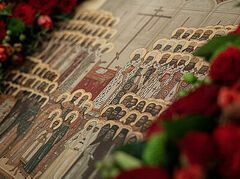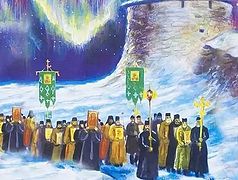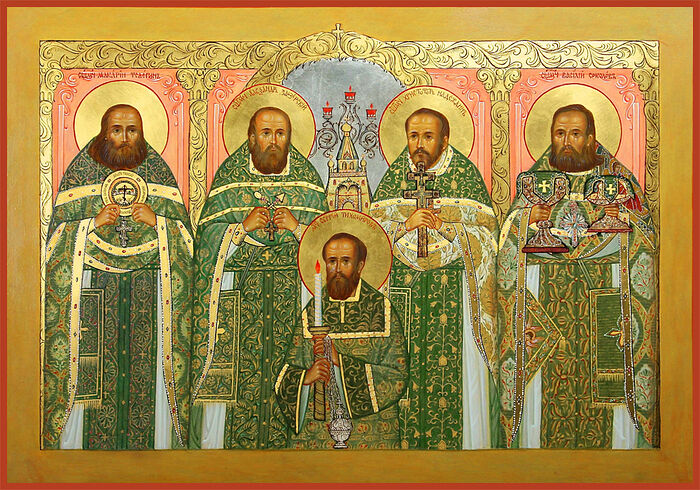 Venerable Martyr Makary (Telegin), Hieromartyrs Alexander Zaozersky, Christopher Nadezhdin, and Vasily Sokolov, and Martyr Sergei Tikhomirov
Venerable Martyr Makary (Telegin), Hieromartyrs Alexander Zaozersky, Christopher Nadezhdin, and Vasily Sokolov, and Martyr Sergei Tikhomirov
One of the stages of the persecution of the Orthodox Church in the first half of the twentieth century was the campaign to seize Church valuables, organized under the pretext of raising funds to help the hungry. And the Holy Trinity-St. Sergius Lavra was also caught up in this sad fate. On April 3, 1922, a commission came to the St. Sergius Church of the Lavra’s Holy Trinity dependency in Moscow, behaving deliberately rudely and blasphemously. One of the monks of the dependency, Hieromonk Makary (Telegin), called them robbers and abusers straight to their faces. His arrest and imprisonment immediately followed. Later, during interrogation, he testified that the members of the commission even put their feet on the altar while removing the valuable adornments of the High Place behind the altar table, which he had to rise up against.
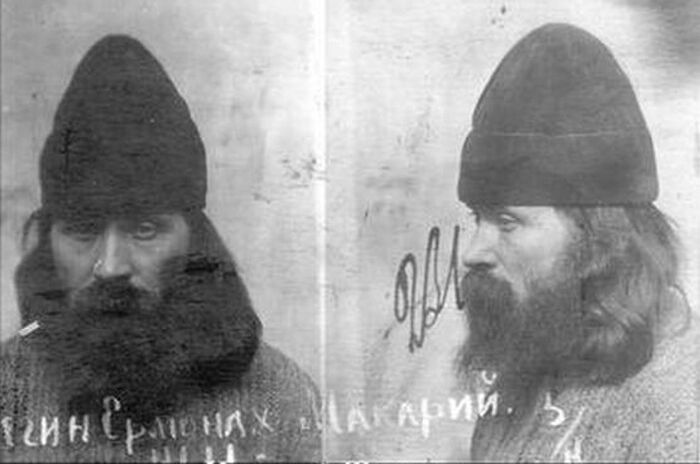 Venerable Martyr Makary (Telegin)
Venerable Martyr Makary (Telegin)
Hieromonk Makary (Makary Nikolaevich Telegin in the world) was born to a peasant family in 1876 in the village of Peremenikha, Buzuluk County, Samara Governorate. He had a miraculous experience in early childhood, after which he decided to dedicate himself to God in monasticism. As a teenager, he often retreated to a remote cave for prayer. While visiting the Kiev Caves Lavra when he was seventeen, he decisively confirmed his decision to take the monastic tonsure, but he had to delay the fulfillment of this intention, because on January 1, 1898, he was called into the army, serving until November 29, 1902.
In 1905, Makary entered the Chudov Monastery in Moscow and bore various obediences there for five years. He was officially enrolled as a novice on October 8, 1910. On January 22, 1911, he was tonsured a monk, on February 1 of the same year he was ordained a hierodeacon, and on September 6, 1913—a hieromonk. With the outbreak of the First World War, Fr. Makary was recalled to active army duty to serve as a priest for the 400th Mobile Hospital. He returned to Chudov Monastery on October 12, 1915, and in 1919, after the monastery was closed, he started serving at St. Sergius’ Church at the Lavra’s Holy Trinity dependency. At his interrogation, Fr. Makary plainly stated that he was “a monarchist by conviction,” and also declared: “I’m a servant of the altar, and it’s very hard for me when sacred items are seized.” His priest cellmate said that Fr. Makary was cheerful and would say: “I can’t wait to meet my Lord Christ.”
Hieromonk Makary was one of fifty-four who were arrested in the “case of the seizure of Church valuables,” or the so-called “Moscow trial of 1922.” The Archpriests Alexander Zaozersky, Christopher Nadezhdin, and Vasily Sokolov, and the layman Sergei Tikhomirov went through this trial together with him.
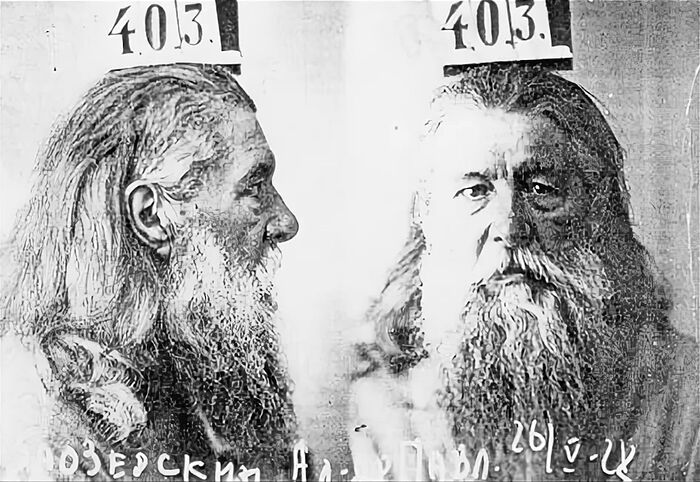 Archpriest Alexander Zaozersky
Archpriest Alexander Zaozersky
Archpriest Alexander Zaozersky was born in Moscow on July 20, 1879, to the family of the priest Nikolai Zaozersky, who served in the Sts. Peter and Paul Church of the Mariinsky Hospital. Fr. Alexander was the rector of the Church of St. Parasceva at Okhotny Ryad in Moscow. During his interrogation, he confessed no guilt, but only said that he had read the epistle of His Holiness Patriarch Tikhon in church. But he refused to name where he got the text of the epistle and the text of the protest to the All-Russian Central Executive Committee, which was signed by hundreds of believers. He was extremely courageous at his trial. When the judges tried to tempt him to testify against others in exchange for a lesser sentence, he refused to give any names. The irate judges named him an ideologue of the clergy who showed the utmost intransigence. When they took Batiushka to Lyubanka Square in Moscow after the trial, he made a huge cross over the crowd of people greeting him.
Archpriest Christopher Nadezhdin was born to a priestly family on February 21, 1869, in the village of Nizhny-Beloomutsk, Zaraisk County, Ryazan Governorate. He graduated from the Zaraisk Theological School, the Ryazan Seminary, and in 1897—the Moscow Theological Academy. He started serving in Moscow in 1901 as the rector of the Church of St. John the Warrior on Yakimanka Street. He was arrested in the “case of the seizure of Church valuables,” but admitted no guilt, and also refused to reveal where he got the epistle of His Holiness Patriarch Tikhon.
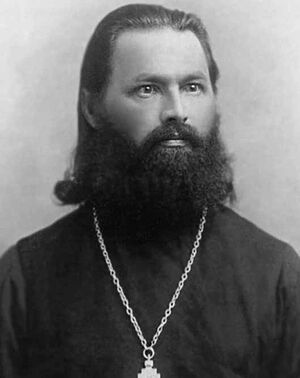 Hieromartyr Vasily Sokolov Fr. Vasily Alexandrovich Sokolov was born in 1868, in the village of Staraya Sloboda, Alexandrov County, Vladimir Governorate. He graduated from the Bethany Seminary, and in 1888, he began serving in the village of Pustoe, Vladimir Governorate. After his wife died, he started studying at the Moscow Theological Academy, graduating in 1910. On December 26, 1910, he began serving at the Church of St. Nicholas on Arbat Street. During his interrogation, he also admitted no guilt in the accusation of agitation against the seizure of Church valuables.
Hieromartyr Vasily Sokolov Fr. Vasily Alexandrovich Sokolov was born in 1868, in the village of Staraya Sloboda, Alexandrov County, Vladimir Governorate. He graduated from the Bethany Seminary, and in 1888, he began serving in the village of Pustoe, Vladimir Governorate. After his wife died, he started studying at the Moscow Theological Academy, graduating in 1910. On December 26, 1910, he began serving at the Church of St. Nicholas on Arbat Street. During his interrogation, he also admitted no guilt in the accusation of agitation against the seizure of Church valuables.
Sergei Fedorovich Tikhomirov was born in 1866 or 1867 to the family of a Moscow merchant of the Second Guild, who had been trading at Okhotny Ryad since 1867. From 1895, Sergei was listed as the independent owner of a butcher shop on Arbat Street. He opened a second store in 1902 in Dorogomilov, where he moved in 1910. His store was located right across from a church. He was one of the first to learn about the looting of the church and rushed to protect the sacred items. He also showed great courage at his trial, pleading no mercy, and refusing the opportunity to give a last word. On May 8, 1922, Sergei and ten clerics with him were tried in the “case of the seizure of Church valuables” and were sentenced to death.
As recorded in the investigation protocol, the detainees were accused of
shifting the blame to the hierarchy, referring to the discipline that existed between them, partly hiding their political goals, like the “Scribes and Pharisees,” justifying their resistance “with lies about God and the laws allegedly established by Him that prohibit giving Church items not only for works of mercy in general, but even for saving the lives of those dying of hunger… despite the fact that the legal expertise invited to the court from a group of faithful Christians categorically recognized such a forfeiture as wholly consistent with Christian teaching…”
After the suspension of the death sentence became known, the prisoners filed a petition, with the permission of the prison warden, for the mitigation of the conditions of their detention, but it was refused. The same day, Stalin sent a note to the members of the Politburo:
“The Moscow court sentenced eleven people to death, most of them priests… Kamenev suggests limiting it to shooting just two priests. I ask you to vote for or against this proposal … from Kamenev. I personally vote against the annulment of the court’s decision.”
A vote took place: Lenin, Trotsky, Stalin, and Zinoviev voted for the death sentence. Thus, on May 18, 1922, the Politburo made the final decision for execution, although only for five of the eleven sentenced. They shaved all of their heads and beards so they couldn’t be recognized as persons of spiritual rank. On May 26, 1922, Hieromonk Makary (Telegin), Archpriests Alexander Zaozersky, Christopher Nadezdhin, and Vasily Sokolov, and the layman Sergei Tikhomirov met their martyric end in the archive room of a former insurance company, where they were shot in the basement, in the back room where the safes were kept. The bodies of the New Martyrs were taken to Kalitnikovskoe Cemetery and buried in an unmarked grave. In August 2000, these spiritual warriors were canonized for Church-wide veneration among the Russian New Martyrs and Confessors at the Jubilee Bishops’ Council of the Russian Orthodox Church.

